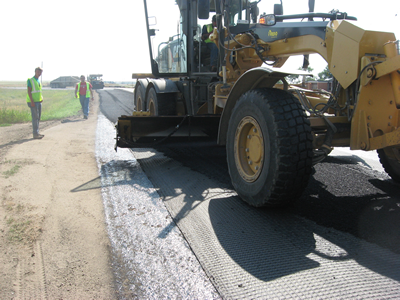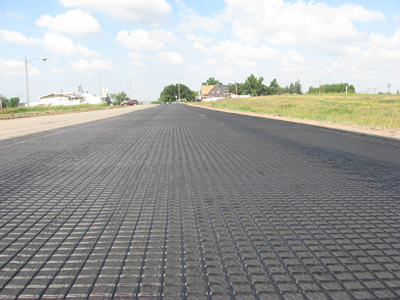
By Chris Kelsey – The Bakken Oil Boom has been great for America as a whole. The boom has employed thousands with good paying jobs, revitalized towns with new economic activity and residents, and decreased the reliance on foreign oil. But local communities, counties, and state officials have also had to deal with the many challenges presented by such rapid growth and the expanding oil operations.
Infrastructure, in particular, has been stressed. Nearly all roads in the Bakken region were constructed years ago and were not designed to handle the current levels of heavy truck and vehicle traffic. The need to rehabilitate and strengthen these under-designed roads has become a matter of preserving roadway safety and fostering sustainable and responsible growth. The wide-spread need has also placed a premium on cost-effective solutions.
For many communities, geogrids have presented the strongest geotechnical answer for supporting the heavy vehicle traffic and weight, extending roadway life, and reducing maintenance costs. Bituminous-coated geogrids have become considerably effective solutions for quick installation into and support of asphalt overlay designs.
REINFORCING NORTH DAKOTA

Geosynthetics are engineered to perform certain functions, such as the reinforcement provided by geogrids. Because of this precision, they are only a small part of civil engineering in general; but they play significant roles in improving the integrity of infrastructure.
In Burke County, North Dakota, the situation in Powers Lake has exemplified the infrastructure challenge, as well as the implementation of an economical geosynthetic solution.
The main road running through the town has connected oil operations and access to larger shipping routes, but the volume and weight of traffic led to significant cracking, oxidation, and other signs of distress and failure in the road. Founded more than 100 years ago, and having never surpassed 650 residents in the US national censuses (conducted every 10 years), Powers Lake was not in a position to command significant roadway funding despite its strategic position in the booming oil market.
The county and design consultant looked at what many communities in this situation have traditionally started with: milling the road and adding a thin asphalt overlay. It would enable some rehabilitation and, importantly, would fit within the cost and construction window constraints. It was not an ideal solution, however, and would still leave the road unprepared for long-term survivability against the known and anticipated usage.
It was the same limitation so many other communities had run up against.
Then an option was presented to utilize a bituminous-coated geogrid composite. Engineered to extend pavement life by strengthening the road against reflective cracking, the polyester geogrid—HaTelit® C40/17 from HUESKER—was a new option for the town and county.
The HaTelit® solution, however, was not an untested production. Long utilized in road projects, its extensive records indicated it could extend pavement overlay life three to four times longer than an unreinforced overlay. The unique composite structure—polyester geogrid with a nonwoven geotextile in a single rolled product—bonds strongly with a roadway in an overlay system because of the bituminous coating. The high modulus geogrid and thin but durable geotextile add significant tensile strength and distribute loads over a greater area, which nullifies the stresses that typically cause reflecting cracking. As a single roll product, the reinforcement can be installed quickly and efficiently during the overlay process.
The design consultant reviewed the proposal and selected HaTelit® as the best solution for this project.
In July 2011, 30,000 sq. yd. of HaTelit® C40/17 was installed on all lanes of 1st Ave W. and Powers Lake Blvd between Hwy 50 and County Road 7. Installation was performed by Border States Paving. Surface preparation included milling and brooming the surface. A thin coat of emulsion (0.12-0.13 gal/SY) was sprayed directly on the milled surface. Once the tack coat broke, the HaTelit® C40/17 was installed with a small tractor laydown machine. To finish the road, 1.5 to 2 in. of asphalt overlay was installed.
The HaTelit® bituminous-coated geogrid solution makes sense for overlays in the Bakken region. It is a robust but easy-to-install geotechnical solution, strengthening roads against the oil and energy industry-related traffic and resisting the freeze-thaw cycles common to the Bakken’s northern soils.
Longer-lasting, safer roads and a decreased need for maintenance are benefiting everyone.
Learn more about HUESKER inc.’s reinforcement expertise and other geosynthetics and services at www.huesker.com.












